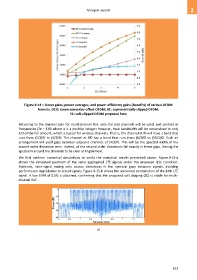Page 623 - 5G Basics - Core Network Aspects
P. 623
Transport aspects 2
Figure 9-14 – Linear gains, power averages, and power-efficiency gains (benefits) of various OFDM
formats. DCO: down-converter-offset OFDM; AC: asymmetrically clipped OFDM;
SC: soft-clipped OFDM proposed here
Returning to the channel plan for multi-channel RoF, only the odd channels will be used, and centred at
frequencies (2n − 1)f0 where n is a positive integer; however, their bandwidth will be constrained to only
2/3 of the full amount, which is typical for wireless channels. That is, the channel at f0 will have a band that
runs from (2/3)f0 to (4/3)f0. The channel at 3f0 has a band that runs from (8/3)f0 to (10/3)f0. Such an
arrangement will yield gaps between adjacent channels of (4/3)f0. This will be the spectral width of the
second order distortion term. Indeed, all the second order distortions fall exactly in these gaps, leaving the
spectrum around the channels to be clear of impairment.
We first perform numerical simulations to verify the analytical results presented above. Figure 9-15-a
shows the simulated spectrum of the same aggregated LTE signals under the proposed QSC condition.
Evidently, inter-signal mixing only causes distortions in the spectral gaps between signals, avoiding
performance degradation to actual signals. Figure 9-15-b shows the recovered constellation of the 24th LTE
signal. A low EVM of 0.5% is obtained, confirming that the proposed soft clipping (SC) is viable for multi-
channel RoF.
a)
613

